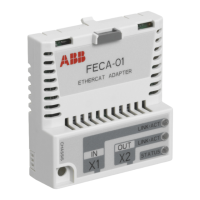Overview of the EtherCAT network and the FECA-01 module 21
Overview of the EtherCAT
network and the FECA-01
module
What this chapter contains
This chapter contains a short description of the EtherCAT network
and the FECA-01 EtherCAT adapter module.
EtherCAT network
EtherCAT is a Real Time Ethernet technology which aims to
maximize the use of the full duplex Ethernet bandwidth. It
overcomes the overhead normally associated with Ethernet by
employing "on the fly" processing hardware.
An EtherCAT bus consists of a master system and up to 65535
slave devices, connected together with standard Ethernet cabling.
The slave devices process the incoming Ethernet frames directly,
extract or insert relevant data and transfer the frame to the next
EtherCAT slave device. The last slave device in the bus segment
sends the fully processed frame back to the master.
There are several application layer protocols defined for EtherCAT.
FECA-01 supports the CANopen application layer over EtherCAT
(CoE), which provides the familiar CANopen communication
mechanisms: Service Data Objects (SDO), Process Data Objects
(PDO) and network management similar to the CANopen protocol.

